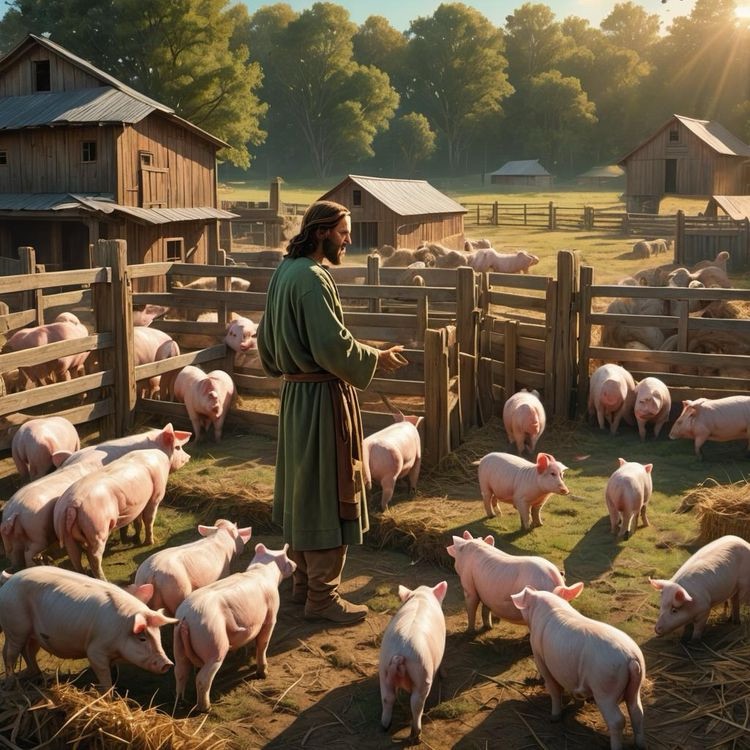As Jesus stood on the farm, He heard a heart-wrenching sound coming from the nearby pen. The pigs, who had gathered to seek justice, began to wail. Their cries were filled with sorrow and longing, and it didn’t take long for Jesus to understand why. In the next pen over, separated by wooden slats, were their babies, huddled together, equally distressed and frightened.
The mother pigs pressed their snouts against the bars, desperate to reach their young. They cried out to be reunited, their hearts heavy with the pain of separation. The tiny piglets squealed, sensing their mothers nearby but unable to reach them. The air was thick with grief, and the sight of this unjust division moved all who stood there.
One of the mother pigs, with tears in her eyes, turned to Jesus and said, “Lord, our babies have been taken from us, and we are powerless to reach them. We cry every day, but no one listens. We long only to be with our children, to care for them as mothers do. Why are we kept apart? Will you not bring justice to this pain?”
As Jesus stood beside the grieving mother pigs, He felt the weight of a much deeper sorrow—the cycles of suffering that extended far beyond this single farm. He knew the reality of the world, the harsh truths of the meat trade, and the fate that awaited these animals. Their lives were seen as commodities, their purpose reduced to flesh, and the cycle of profit and consumption seemed unbreakable. Jesus understood the pain and injustice of it all, for He saw the suffering not only here, but across the world.
Yet, despite His knowledge of the outcome, Jesus did not bring anger or judgment. He knelt once again, resting His hand upon the earth, and spoke to the pigs with a gentle wisdom.
“I know the burden you carry,” He said. “I know the harshness of the world in which you live. This system, this cycle, has existed for generations, and its cruelty weighs heavy on all of creation. Yet, I ask you to trust in God, for even when the world seems unjust, His love holds all things. Your suffering does not go unseen, and your cries are not unheard.”
The pigs, though still filled with grief, listened intently. Their pain was great, but they sensed the truth in Jesus’ words—a truth deeper than the cruelty they faced. Though they could not fully understand, they felt a peace settle within them.
Jesus then turned to the people who watched. His mind spoke, though no audible sound came forth it carried the weight of divine understanding. “The cycles of this world are built on power and profit, often at the expense of the innocent. But know this: God sees all, and there is justice in His time, even when it seems far away. You are stewards of His creation, and how you treat the least of these reflects the state of your own hearts. There is still time to choose compassion.”
Though Jesus did not change the fate of the pigs in that moment, He left a greater gift—the seed of trust. He encouraged them to surrender their suffering to God, knowing that in His hands, no pain is wasted, and no injustice is left unhealed forever. The pigs, who had once only known fear, began to trust in something greater than the world’s harsh cycles.
The people, too, were left to ponder His words. Some turned away, too set in their ways to change. But others felt their hearts stir, and over time, they began to see the animals not as mere products, but as part of God’s creation deserving of care and respect. The system did not change overnight, but the understanding that Jesus had planted began to grow, spreading slowly but surely.
As Jesus left the farm, He glanced back at the pigs, their eyes meeting His, and though their future was uncertain in the eyes of men, in the eyes of God, they were held in His eternal care. The message Jesus left was clear: even in a world filled with suffering, trust in God’s plan, for justice, love, and peace will prevail in the end.
Though He did not tear down the fence Himself, He planted seeds of compassion in the hearts of the people, and over time, their actions began to change. The farmers, moved by the scene and the wisdom of Jesus, began to treat the animals with greater care. The pens were opened, and the mothers were finally reunited with their babies, their cries replaced with gentle grunts of relief and joy.
The separation and cycles that cause so much suffering can be mended, not by force, but by the softening of hearts and a greater respect for life cycles, In that moment, the pigs and the people both learned that true justice is not found in power, but in compassion and understanding. And in trusting the balance of life.
